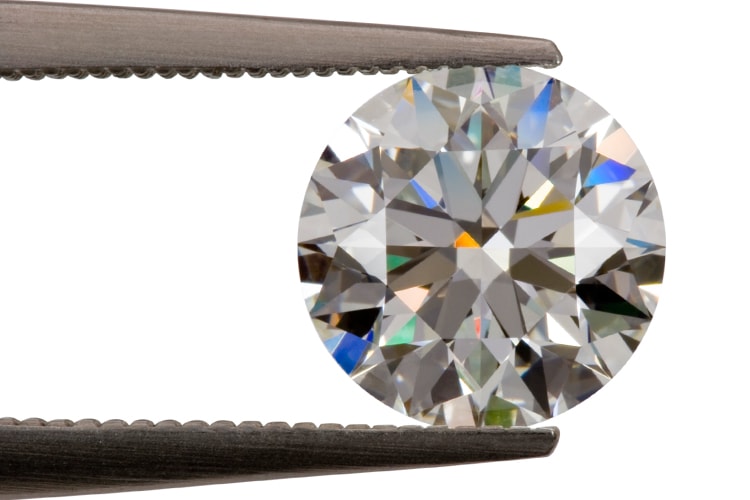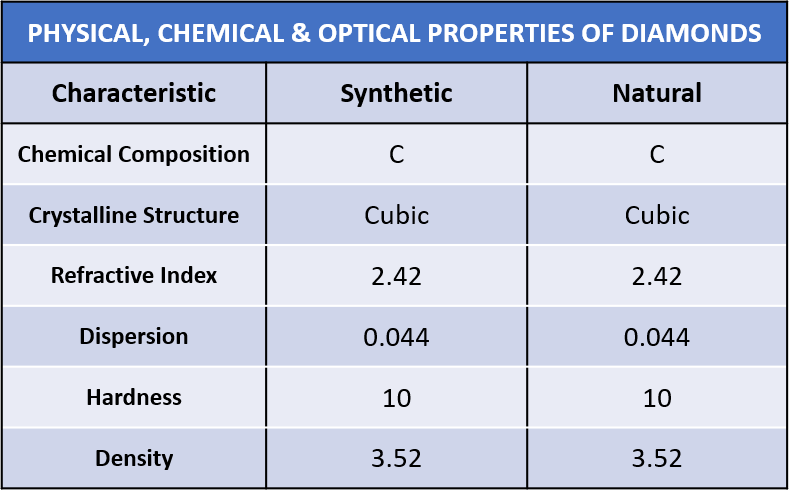Lab-Grown-Diamonds Over the Counter

In this excerpt from the Diamonds course by the Diamond Council of America, you’ll learn how to discuss lab-grown diamonds with customers. DCA is a non-profit organization that provides quality, affordable distance education and the opportunity to earn professional certifications in diamonds, colored gemstones and fine jewelry sales.
Lab-grown diamonds are pure carbon, just like mined diamonds. They have essentially the same gemological properties as natural diamond too. The primary differences between lab-grown diamonds and mined diamonds are where, when, and how they form. It’s these variations that leave the hidden clues that help us differentiate between the two.

Here are the simple definitions that explain the difference between natural diamonds and lab-grown diamonds:
- Natural Diamond: Pure carbon crystallized in the isometric system formed by geologic (rock-forming) processes deep inside the earth, without human involvement.
- Lab-Grown Diamond: Pure carbon crystallized in the isometric system, produced in a factory or manufacturing facility. Lab-grown diamonds have essentially the same chemical, physical and optical properties as a natural diamond, but were produced by a human-engineered process.
Lab-grown diamonds are, in fact, diamonds. They are just a specific type of diamond, and that fact must be made clear to the consumer. According to the FTC, if you use the word “diamond” unqualified in sales or marketing materials, you must be referring to a natural gem. You can’t call a manufactured stone a diamond without using a qualifying term like lab-grown, lab-created, man-made, brand-name-created, or similar immediately preceding the word ‘diamond’. The FTC rule makes sense for responsible sales professionals, since consumers should have a clear understanding of what they are buying. Transparency is especially important in this case, since there is a significant value difference between the natural and created gems.
Geologists agree that natural diamonds formed between one and four billion years ago, 100 miles below the earth’s surface in the cores of continents. In the extreme heat and pressure deep in the earth, carbon crystallized naturally.
Because diamonds formed so long ago and were brought to the surface by geologic processes that no longer continue, the supply of natural diamonds is inherently limited. Many of the mines and deposits that have been discovered over the years are now depleted and most analysts expect the supply of natural diamonds to decline over time. That’s why diamonds are, in fact, rare – especially in fine qualities and large sizes. If demand continues or increases, you can expect prices to stay the same or increase. That means that natural diamonds hold value over time.
Lab-grown diamonds are produced in factories using high-tech crucibles, over a period of a few days or weeks. Specially created conditions allow carbon to crystallize by bonding to the carbon atoms in a diamond seed.
As manufacturing techniques continue to improve, the supply of lab-grown diamonds will continue to increase. Prices for lab-grown diamonds have dropped steadily as more and more producers have taken advantage of advancing technology to ramp up output. It’s reasonable to expect that this will continue – so it’s also reasonable to expect that much like other products of technology, lab-grown diamonds will continue to decline in price and in value.
Many lab-grown diamond companies describe their diamonds in advertising as being sustainable or “eco-friendly.” In reality, however, these diamonds are manufactured using equipment that consumes a great deal of energy. Mining operations use lots of energy too, including in heavy-duty equipment to move and process massive amounts of earth. In both cases though, their environmental impact largely depends on the source of that energy.
Both miners and growers are trying to reduce their carbon footprints, so the difference between the two products may not always be as clear-cut as it seems. The FTC Guides caution against describing any product as “environmentally friendly” or “sustainable” without also including the criteria you are using for measurement. It’s not enough to be comparatively better.
In the view of some consumers, lab-grown diamonds may come with fewer social or environmental issues than mined diamonds. On the other hand, the mining industry provides jobs, education, health care and many other resources to developing nations around the globe. What’s better depends on what is most important to the buyer. As a professional, your role is to stick to the facts, provide accurate information, and let your customer take the lead.
LAB-GROWN IDENTIFICATION
All lab-grown diamonds can be separated from natural diamonds by a gemological laboratory. Grading reports for lab-grown diamonds clearly identify them and diamonds manufactured by most reputable companies are girdle-inscribed with a clear indicator of origin.
It is important to note though that neither you nor your customers will be able to differentiate between lab-grown diamonds and mined diamonds just by looking at them. Because they mirror the physical, chemical, and optical properties of natural diamonds, lab-grown diamonds look the same. They are also evaluated using the same 4Cs as natural diamonds.
This isn’t true of diamond imitators like cubic zirconia, moissanite, and colorless synthetic sapphire, all of which are different minerals with different physical, optical and chemical properties than diamond. These simulants are easily identified by the trained eye and can be quickly separated from diamonds with an inexpensive diamond tester.
There are a number of gemological techniques for identifying lab-grown diamonds. The most common are based on UV testing. Because UV testing reveals the growth layers of diamonds, it highlights the differences in the way that diamonds are formed in the earth vs in the manufacturing facility.
If a diamond is more strongly fluorescent to short-wave UV light than to long-wave UV light, it is very likely a lab-grown diamond. Lab-grown diamonds also show very characteristic growth patterns resulting from their crystal structure when exposed to deep UV light. Many lab-grown diamonds also phosphoresce after being exposed to a UV source. Labs also use absorption spectroscopy to separate manufactured diamonds from those mined from the earth.
With advancing technology, detecting lab-grown diamonds has actually become fairly easy for retailers and there are a number of highly accurate ‘at the counter’ screening devices available. If your store has one, you will be able to demonstrate to customers that it’s possible to tell the difference between natural and lab-grown diamonds easily and effectively.
Created diamonds are most likely to cause problems for jewelry retailers when they’re misidentified. This can occur during take-in for repair, appraisal, or other services. To avoid liability and potential customer service issues, it’s essential to know and follow your company’s procedures for service take-in.
For your customers, the fact that lab-grown diamonds and natural diamonds can’t be separated by sight alone means that they need to trust the retail store where they buy their diamonds. But it also means that if they choose to buy a lab-grown diamond, their friends and family won’t know unless they choose to tell them.
THE LAB-GROWN CHOICE
Lab-grown diamonds have several features that differentiate them from natural diamonds. For some customers, these features may make them an attractive choice. For others, they may be a reason to choose a natural diamond instead.
When presenting lab-grown diamonds, learning about the customer’s emotional reasons for making the purchase is an essential part of the process – just as it is when presenting natural diamonds. When you understand what’s important to your customer, features of lab-grown diamonds can be presented as appropriate benefits that add value based on your customer’s individual needs and interests.
For fashion jewelry gift buyers and self-purchasers, lab-grown diamonds can represent a comfortable, cost effective, or even colorful option for everyday wear. If your bridal customer is price-driven, lab-grown diamonds may offer them the opportunity to get the quality and size diamond they want without exceeding their budget. Other customers may see the lab-grown option as an opportunity to save money, to get a larger diamond than they expected or to select a more elaborate engagement ring setting than they had planned.
Some customers see lab-grown diamonds as a way to avoid conflict diamonds or the environmental impact of mining. Still others are attracted by the fact that lab-grown diamonds are a very cool, high-tech innovation.
She may prefer a mined diamond because it’s one of nature’s miracles or because it has lasting value. He may be interested in a lab-created diamond because of its clean origin or high-tech provenance. They may feel a lab-grown diamond signifies a modern love or that it represents their values.
For some, a lab-grown diamond can fill the emotional need for a diamond that says what they want it to say just as well as a mined diamond can. By listening to the customer’s questions and reactions to the story of lab-grown diamonds, you’ll know how best to present the right options.
Only your customer knows what’s right for his or her needs. It’s not about competition between mined and manufactured diamonds, it’s about options and choices that matter to the consumer. It comes down to what’s most important to them.
Source: Diamond Council of America, www.dcalearning.org